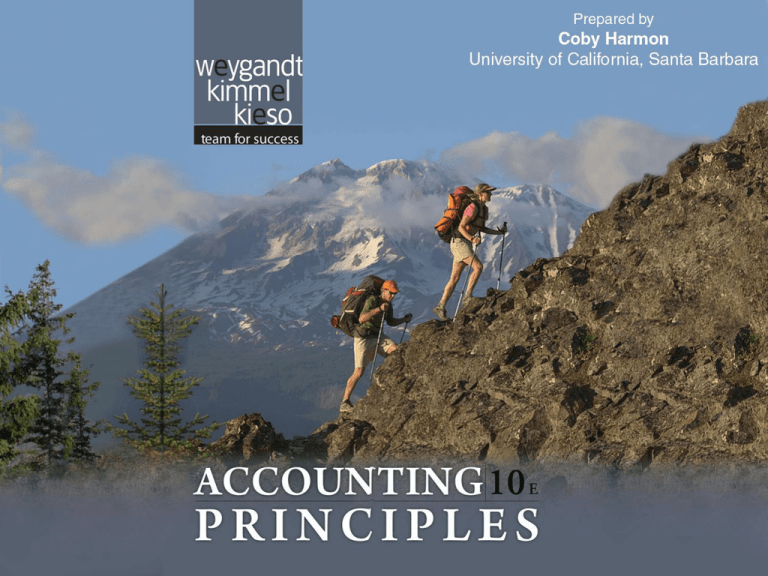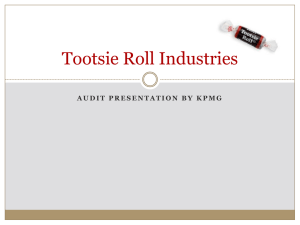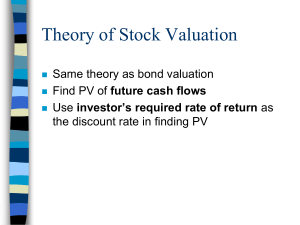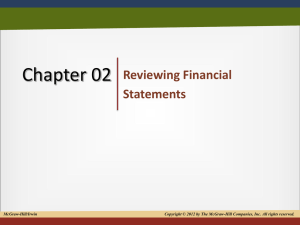
14-1
CHAPTER14
Corporations:
Dividends,
Retained
Earnings, and
Income Reporting
14-2
PreviewofCHAPTER14
14-3
Dividends
Distribution of cash or stock to stockholders on a pro
rata (proportional) basis.
Types of Dividends:
1. Cash dividends.
3. Stock dividends.
2. Property dividends.
4. Scrip.
Dividends expressed: (1) as a percentage of the par or
stated value, or (2) as a dollar amount per share.
14-4
SO 1 Prepare the entries for cash dividends and stock dividends.
Dividends
Three dates:
14-5
SO 1 Prepare the entries for cash dividends and stock dividends.
Dividends
Cash Dividends
For a corporation to pay a cash dividend, it must have:
1. Retained earnings - Payment of cash dividends from
retained earnings is legal in all states.
2. Adequate cash.
3. A declaration of dividends by the Board of Directors.
14-6
SO 1 Prepare the entries for cash dividends and stock dividends.
Dividends
Illustration: On Dec. 1, the directors of Media General declare a
50¢ per share cash dividend on 100,000 shares of $10 par value
common stock. The dividend is payable on Jan. 20 to
shareholders of record on Dec. 22?
December 1 (Declaration Date)
Cash dividends
Dividends payable
December 22 (Date of Record)
50,000
50,000
No entry
January 20 (Payment Date)
Dividends payable
Cash
14-7
50,000
50,000
SO 1 Prepare the entries for cash dividends and stock dividends.
Dividends
Allocating Cash Dividends Between Preferred
and Common Stock
Holders of cumulative preferred stock must be paid
any unpaid prior-year dividends before common
stockholders receive dividends.
14-8
SO 1 Prepare the entries for cash dividends and stock dividends.
Dividends
Illustration: On December 31, 2012, IBR Inc. has 1,000 shares
of 8%, $100 par value cumulative preferred stock. It also has
50,000 shares of $10 par value common stock outstanding. At
December 31, 2012, the directors declare a $6,000 cash dividend.
Prepare the entry to record the declaration of the dividend.
Cash dividends
6,000
Dividends payable
6,000
Pfd Dividends: 1,000 shares x $100 par x 8% = $8,000
14-9
SO 1 Prepare the entries for cash dividends and stock dividends.
Dividends
Illustration: At December 31, 2013, IBR declares a $50,000
cash dividend. Show the allocation of dividends to each class of
stock.
2012
Dividends declared
$
2013
6,000
Dividends in arrears
Allocation to preferred
Remainder to common
6,000
$
-
$ 50,000
2,000 **
8,000 *
$ 40,000
* 1,000 shares x $100 par x 8% = $8,000
** 2012 Pfd. dividends $8,000 – declared $6,000 = $2,000
14-10
SO 1 Prepare the entries for cash dividends and stock dividends.
Dividends
Illustration: At December 31, 2013, IBR declares a $50,000 cash
dividend. Prepare the entry to record the declaration of the
dividend.
Cash dividends
Dividends payable
14-11
50,000
50,000
SO 1 Prepare the entries for cash dividends and stock dividends.
14-12
Dividends
Stock Dividends
Illustration 14-3
Pro rata distribution of the corporation’s own stock.
Results in decrease in retained earnings and increase in paid-in capital.
14-13
SO 1 Prepare the entries for cash dividends and stock dividends.
Dividends
Stock Dividends
Reasons why corporations issue stock dividends:
1. Satisfy stockholders’ dividend expectations without
spending cash.
2. Increase marketability of the corporation’s stock.
3. Emphasize a portion of stockholders’ equity has been
permanently reinvested in the business.
14-14
SO 1 Prepare the entries for cash dividends and stock dividends.
Dividends
Stock Dividends
Small stock dividend (less than 20–25% of the
corporation’s issued stock, recorded at fair market
value) *
Large stock dividend (greater than 20–25% of issued
stock, recorded at par value)
* Accounting based on the assumption that a small stock dividend will
have little effect on the market price of the outstanding shares.
14-15
SO 1 Prepare the entries for cash dividends and stock dividends.
Dividends
Illustration: HH Inc. has 5,000 shares issued and outstanding.
The per share par value is $1, book value $32 and market value is
$40.
10% stock dividend is declared
Stock dividends (5,000 x 10% x $40)
Common stock dividends distributable
Paid-in capital in excess of par value
20,000
500
19,500
Stock issued
Common stock dividends distributable
Common stock (5,000 x 10% x $1)
14-16
500
500
SO 1 Prepare the entries for cash dividends and stock dividends.
Dividends
Stockholders’ Equity with Dividends Distributable
HH Inc.
Balance Sheet (partial)
Stockholders' equity
Paid-in capital
Common stock, $1 par, 5,000 issued
and outstanding
Common stock dividends distributable
Paid-in capital in excess of par
Retained earnings
Total stockholders' equity
14-17
$
5,000
500
64,500
90,000
$ 160,000
SO 1 Prepare the entries for cash dividends and stock dividends.
Dividends
Effects of Stock Dividends
Before
Dividend
HH Inc.
Stockholders' equity
Paid-in capital
Common stock, $1 par, 5,000 issued
and outstanding
Paid-in capital in excess of par
Retained earnings
Total stockholders' equity
Outstanding shares
Book value per share
14-18
5,000
45,000
110,000
$ 160,000
$
$
5,000
32
After
Dividend
Net
Change
5,500
64,500
90,000
$ 160,000
$ 500
19,500
(20,000)
$
$
$
0
5,500
29
SO 1 Prepare the entries for cash dividends and stock dividends.
Dividends
Question
Which of the following statements about small stock dividends
is true?
a. A debit to Stock Dividends for the par value of the shares
issued should be made.
b. A small stock dividend decreases total stockholders’
equity.
c. Market value per share should be assigned to the
dividend shares.
d. A small stock dividend ordinarily will have no effect on
book value per share of stock.
14-19
SO 1 Prepare the entries for cash dividends and stock dividends.
Dividends
Question
In the stockholders’ equity section, Common Stock Dividends
Distributable is reported as a(n):
a. deduction from total paid-in capital and retained
earnings.
b. current liability.
c. deduction from retained earnings.
d. addition to capital stock.
14-20
SO 1 Prepare the entries for cash dividends and stock dividends.
Dividends
Stock Split
14-21
Reduces the market value of shares.
No entry recorded for a stock split.
Decrease par value and increase number of shares.
SO 1 Prepare the entries for cash dividends and stock dividends.
Dividends
Illustration: HH Inc. has 5,000 shares issued and
outstanding. The per share par value is $1, book value
$32 and market value is $40.
2 for 1 Stock Split
No Entry -- Disclosure that par is now $.50 and shares
outstanding are 10,000.
14-22
SO 1 Prepare the entries for cash dividends and stock dividends.
Dividends
Effects of Stock Splits
Stockholders' equity
Paid-in capital
Common stock
Paid-in capital in excess of par
Retained earnings
Total stockholders' equity
Outstanding shares
Book value per share
14-23
After
Split
Before
Split
HH Inc.
5,000
45,000
110,000
$ 160,000
$
$
5,000
32
5,000
45,000
110,000
$ 160,000
$
Net
Change
$
$
-
10,000
16
$
SO 1 Prepare the entries for cash dividends and stock dividends.
14-24
Retained Earnings
Net income increases Retained Earnings and a net
loss decreases Retained Earnings.
Part of the stockholders’ claim on the total assets of
the corporation.
Debit balance in Retained Earnings is identified as a
deficit.
Illustration 14-9
14-25
SO 2 Identify the items reported in a retained earnings statement.
Retained Earnings
Retained Earnings Restrictions
Restrictions can result from:
1. Legal restrictions.
2. Contractual restrictions.
3. Voluntary restrictions.
Companies generally disclose retained earnings restrictions in
the notes to the financial statements.
14-26
SO 2 Identify the items reported in a retained earnings statement.
Retained Earnings
Prior Period Adjustments
Correction of an error in previously issued financial
statements.
Result from:
14-27
►
mathematical mistakes.
►
mistakes in application of accounting principles.
►
oversight or misuse of facts.
Adjustment made to the beginning balance of retained
earnings.
SO 2 Identify the items reported in a retained earnings statement.
Retained Earnings Statement
Woods, Inc.
Statement of Retained Earnings
For the Year Ended December 31, 2012
Balance, January 1
Net income
Dividends
Balance, December 31
$
$
1,050,000
360,000
(300,000)
1,110,000
Before issuing the report for the year ended December 31, 2012, you discover a
$50,000 error (net of tax) that caused the 2011 inventory to be overstated
(overstated inventory caused COGS to be lower and thus net income to be higher in
2011. Would this discovery have any impact on the reporting of the Statement of
Retained Earnings for 2012?
14-28
SO 2 Identify the items reported in a retained earnings statement.
Retained Earnings Statement
Woods, Inc.
Statement of Retained Earnings
For the Year Ended December 31, 2012
Balance, January 1, as previously reported
Prior period adjustment - error correction
Balance, January 1, as restated
Net income
Dividends
Balance, December 31
14-29
$
$
1,050,000
(50,000)
1,000,000
360,000
(300,000)
1,060,000
SO 2 Identify the items reported in a retained earnings statement.
Retained Earnings Statement
Debits and Credits to Retained Earnings
Illustration 14-13
14-30
SO 2 Identify the items reported in a retained earnings statement.
Retained Earnings Statement
Question
All but one of the following is reported in a retained
earnings statement. The exception is:
a. cash and stock dividends.
b. net income and net loss.
c. some disposals of treasury stock below cost.
d. sales of treasury stock above cost.
14-31
SO 2 Identify the items reported in a retained earnings statement.
Statement Presentation and Analysis
Stockholders’
Equity
Presentation
Illustration 14-15
14-32
SO 3
Statement Presentation and Analysis
Stockholders’ Equity Analysis
Return on
Common
Stockholders’
Equity
Net Income Available to
Common Stockholders
=
Average Common
Stockholders’ Equity
Ratio shows how many dollars of net income the company
earned for each dollar invested by the stockholders.
14-33
SO 3 Prepare and analyze a comprehensive stockholders’ equity section.
Statement Presentation and Analysis
Illustration 14-17
Income
Statement
Presentation
14-34
SO 4 Describe the form and content of corporation income statements.
Statement Presentation and Analysis
Income Statement Analysis
Earnings
Per Share
Net Income minus
Preferred Dividends
=
Weighted-Average Common
Shares Outstanding
Ratio indicates the net income earned by each share of
outstanding common stock.
14-35
SO 5 Compute Earnings Per Share.
Statement Presentation and Analysis
Question
The income statement for Nadeen, Inc. shows income
before income taxes $700,000, income tax expense
$210,000, and net income $490,000. If Nadeen has
100,000 shares of common stock outstanding throughout
the year, earnings per share is:
a. $7.00.
b. $4.90.
($490,000 / 100,000 = $4.90)
c. $2.10.
d. No correct answer is given.
14-36
SO 5 Compute Earnings Per Share.
Key Points
14-37
The term reserves is used in IFRS to indicate all non–
contributed (non–paid-in capital). Reserves include retained
earnings and other comprehensive income items, such as
revaluation surplus and unrealized gains or losses on availablefor sale securities.
IFRS often uses terms such as retained profits or accumulated
profit or loss to describe retained earnings. The term retained
earnings is also often used.
Key Points
14-38
The accounting related to prior period adjustment is essentially
the same under IFRS and GAAP. One area where IFRS and
GAAP differ in reporting relates to error corrections in
previously issued financial statements. While IFRS requires
restatement with some exceptions, GAAP does not permit any
exceptions.
The stockholders’ equity section is essentially the same under
IFRS and GAAP. However, terminology used to describe certain
components is often different.
Equity is given various descriptions under IFRS, such as
shareholder’s equity, owners’ equity, capital and reserves, and
shareholders’ funds.
Key Points
14-39
The income statement using IFRS is called the statement of
comprehensive income. A statement of comprehensive income
is presented in a one- or two-statement format. The singlestatement approach includes all items of income and expense,
as well as each component of other comprehensive income or
loss by its individual characteristic. In the two-statement
approach, a traditional income statement is prepared. It is then
followed by a statement of comprehensive income, which starts
with net income or loss and then adds other comprehensive
income or loss items.
The computations related to earnings per share are essentially
the same under IFRS and GAAP.
Looking into the Future
The IASB and the FASB are currently working on a project related
to financial statement presentation. An important part of this study
is to determine whether certain line items, subtotals, and totals
should be clearly defined and required to be displayed in the
financial statements. For example, it is likely that the statement of
stockholders’ equity and its presentation will be examined closely.
14-40
IFRS Self-Test Questions
The basic accounting for cash dividends and stock dividends:
a) is different under IFRS versus GAAP.
b) is the same under IFRS and GAAP.
c) differs only for the accounting for cash dividends between
GAAP and IFRS.
d) differs only for the accounting for stock dividends
between GAAP and IFRS.
14-41
IFRS Self-Test Questions
Which item in not considered part of reserves?
a) Unrealized loss on available-for-sale investments.
b) Revaluation surplus.
c) Retained earnings.
d) Issued shares.
14-42
IFRS Self-Test Questions
Under IFRS, a statement of comprehensive income must
include:
a) accounts payable.
b) retained earnings.
c) income tax expense.
d) preference stock.
14-43
Copyright
“Copyright © 2011 John Wiley & Sons, Inc. All rights reserved.
Reproduction or translation of this work beyond that permitted in
Section 117 of the 1976 United States Copyright Act without the
express written permission of the copyright owner is unlawful.
Request for further information should be addressed to the
Permissions Department, John Wiley & Sons, Inc. The purchaser
may make back-up copies for his/her own use only and not for
distribution or resale. The Publisher assumes no responsibility for
errors, omissions, or damages, caused by the use of these programs
or from the use of the information contained herein.”
14-44










